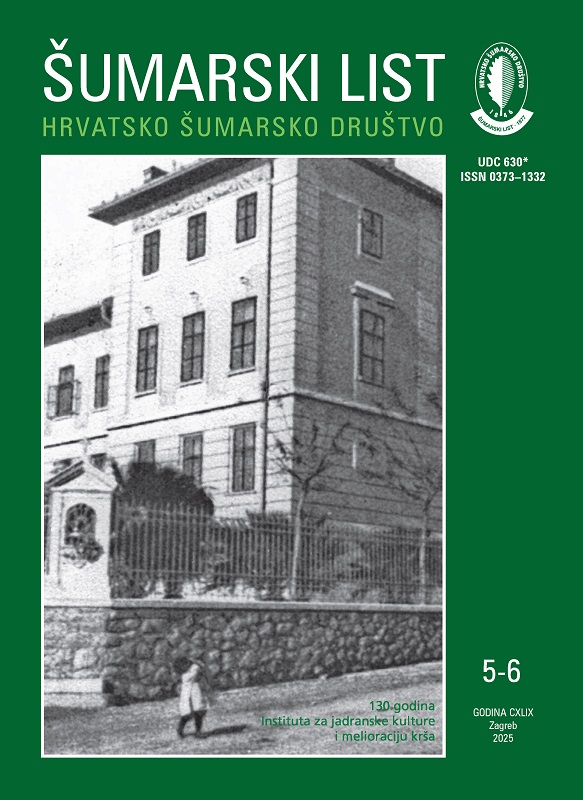| |
| RIJEČ UREDNIŠTVA |
| |
|
|
| Uredništvo HŠD | |
| Should we be surprised by the higher export of timber than furniture from Croatia?
pdf
HR
EN
|
217 |
| |
| IZVORNI ZNANSTVENI ČLANCI |
| |
|
|
| Tatjana Mandić Bulić, Marilena Idžojtić | UDKps://doi.org/10.31298/sl.149.5-6.1 |
| Woody plants of the Brijuni national park
pdf
HR
EN
|
219 |
| Esmera Kajtaz, Dženita Alibegić, Haris Nikšić, Željko Španjol, Boris Dorbić | UDKps://doi.org/10.31298/sl.149.5-6.2 |
| Determination of antioxidant profile of the essential oil and extract samples obtained from lavender (Lavandula angustifolia Miller)
pdf
HR
EN
|
233 |
Lavender (Lavandula angustifolia Miller) is a low, perennial shrub that grows in countries around the western Mediterranean. It originates from sunny rocky areas and is primarily cultivated for its essential oils. Various studies have shown that certain types of medicinal plants, such as L. angustifolia Miller, containing linalool and linalyl acetate ester, have a mild sedative effect and are used in aromatherapy and phytotherapy to relieve stress. The aim of this study is to determine the antioxidant activity of lavender samples. Samples of plant material were collected from the following areas: Gubavica (municipality of Mostar) and Šehovina (city of Mostar). The following samples were analyzed: the essential oil obtained by hydrodistillation of the plant material (Gubavica), the sample macerated in ethyl acetate (Šehovina), the collected aqueous residue after hydrodistillation, and commercial essential oil. The determination of the antioxidant activity of the samples was carried out using the following methods: DPPH, ABTS, and FRAP. Hydrodistilled essential oil, as well as commercial oil, showed weaker antioxidant activity, which was confirmed by all the methods used. Weaker antioxidant activity was also observed in the analysis of the ethyl acetate sample. By monitoring the reaction progress for the aforementioned samples it was impossible to calculate the IC50 value. The aqueous residue after hydrodistillation showed the highest antioxidant activity according to all methods used, confirmed by the IC50 value according to the DPPH method, which was 0.032 ± 0.006 mg/mL, while for the ABTS method, the IC50 value was 0.135 ± 0.003 mg/mL. Also, according to the FRAP method, the aqueous residue after hydrodistillation exhibited the best antioxidant activity (1099.45 ± 25.39 mg Evit. C/g of the extract). By comparing the chemical composition and antioxidant activity of the tested samples, it can be concluded that the antioxidant effect is due to the phenolic compounds found in the aqueous residue after the hydrodistillation of the essential oil, which exhibited the best activity. In contrast, the compounds that make up the essential oil itself have only minor effectiveness regarding antioxidant capacity.
|
| Ayşegül Tekeş, Serkan Özdemir, Candan Aykurt, Serkan Gülsoy, Kürşad Özkan | UDKps://doi.org/10.31298/sl.149.5-6.3 |
| Species distribution modeling of red hawthorn (Crataegus monogyna Jacq.) in response to climate change
pdf
HR
EN
|
243 |
| Ali Bayraktar, Deniz Güney, Fahrettin Atar, Ibrahim Turna | UDKps://doi.org/10.31298/sl.149.5-6.4 |
| Evaluation of rooting responses in Lagerstroemia indica L. cuttings under different greenhouse settings, rooting media, and phytohormonal applications
pdf
HR
EN
|
255 |
| Hediye Aktaş Aytepe, Ali Kavgaci | UDKps://doi.org/10.31298/sl.149.5-6.5 |
| Syntaxonomical contribution to the vegetation classification of Türkiye from SW Anatolia: a plant diversity hotspot
pdf
HR
EN
|
265 |
| |
| PREGLEDNI ČLANCI |
| |
|
|
| Igor Anić | UDKps://doi.org/10.31298/sl.149.5-6.6 |
| History of pedunculate oak forest regeneration in Croatia
pdf
HR
EN
|
279 |



